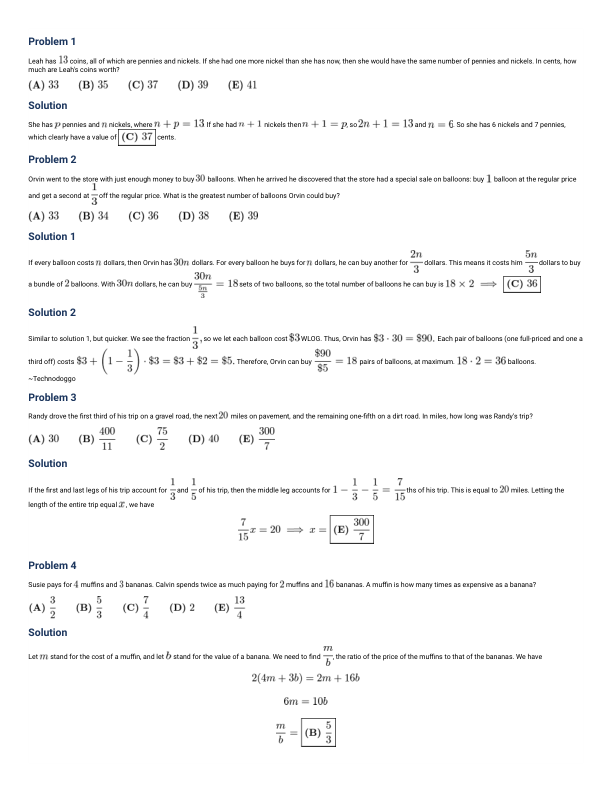2014 AMC amc12b 真题 答案 详解
| 序号 | 文件列表 | 说明 | ||
|---|---|---|---|---|
| 1 | 2014-amc12b-paper-eng-zh.pdf | 10 页 | 408.48KB | 中英双语真题 |
| 2 | 2014-amc12b-paper-eng.pdf | 4 页 | 235.54KB | 英文真题 |
| 3 | 2014-amc12b-key.pdf | 1 页 | 10.22KB | 真题答案 |
| 4 | 2014-amc12b-solution-eng.pdf | 19 页 | 1.48MB | 真题文字详解(英文) |
| 5 | 2014-amc12b-solution-eng-zh.pdf | 19 页 | 1.50MB | 真题文字详解(中英双语) |
| 6 | 2014-amc12b-solution-video-zh.mp4 | 25.83 分钟 | 53.78MB | 真题视频详解(普通话) |
中英双语真题
2014 AMC12B
Problem 1
Leah has 13 coins, all of which are pennies and nickels. If she had one more nickel than she has now, then she would have the same number of pennies and nickels. In cents, how much are Leah's coins worth?
(A) 33 (B) 35 (C) 37 (D) 39 (E) 41
Problem 2
Orvin went to the store with just enough money to buy 30 balloons. When he arrived he discovered that the store had a special sale on balloons: buy 1 balloon at the regular price and get a second (\frac{1}{3}) off the regular price. What is the greatest number of balloons Orvin could buy?
(A) 33 (B) 34 (C) 36 (D) 38 (E) 39
Problem 3
Randy drove the first third of his trip on a gravel road, the next 20 miles on pavement, and the remaining one-fifth on a dirt road. In miles, how long was Randy's trip?
(A) 30 (B) (\frac{400}{11}) (C) (\frac{75}{2}) (D) 40 (E) (\frac{300}{7})

英文真题
2014 AMC 12B Problems
Problem 1
Leah has 13 coins, all of which are pennies and nickels. If she had one more nickel than she has now, then she would have the same number of pennies and nickels. In cents, how much are Leah's coins worth?
(A) 33
(B) 35
(C) 37
(D) 39
(E) 41
Problem 2
Orvin went to the store with just enough money to buy 30 balloons. When he arrived he discovered that the store had a special sale on balloons: buy 1 balloon at the regular price and get a second at (\frac{1}{3}) off the regular price. What is the greatest number of balloons Orvin could buy?
(A) 33
(B) 34
(C) 36
(D) 38
(E) 39
Problem 3
Randy drove the first third of his trip on a gravel road, the next 20 miles on pavement, and the remaining one-fifth on a dirt road. In miles, how long was Randy's trip?
(A) 30
(B) (\frac{400}{11})
(C) (\frac{75}{2})
(D) 40
(E) (\frac{300}{7})
Problem 4
Susie pays for 4 muffins and 3 bananas. Calvin spends twice as much paying for 2 muffins and 16 bananas. A muffin is how many times as expensive as a banana?
(A) (\frac{3}{2})
(B) (\frac{5}{3})
(C) (\frac{7}{4})
(D) 2
(E) (\frac{13}{4})
Problem 5
Doug constructs a square window using 8 equal-size panes of glass, as shown. The ratio of the height to width for each pane is (5:2), and the borders around and between the panes are 2 inches wide. In inches, what is the side length of the square window?
(A) 26
(B) 28
(C) 30
(D) 32
(E) 34
Problem 6
Ed and Ann both have lemonade with their lunch. Ed orders the regular size. Ann gets the large lemonade, which is 50% more than the regular. After both consume (\frac{3}{4}) of their drinks, Ann gives Ed a third of what she has left, and 2 additional ounces. When they finish their lemonades they realize that they both drank the same amount. How many ounces of lemonade did they drink together?
(A) 30
(B) 32
(C) 36
(D) 40
(E) 50

真题文字详解(英文)
Problem 1
Leah has 13 coins, all of which are pennies and nickels. If she had one more nickel than she has now, then she would have the same number of pennies and nickels. In cents, how much are Leah's coins worth?
(A) 33 (B) 35 (C) 37 (D) 39 (E) 41
Solution
She has p pennies and n nickels, where n + p = 13. If she had n + 1 nickels then n + 1 = p, so 2n + 1 = 13 and n = 6. So she has 6 nickels and 7 pennies, which clearly have a value of (C) 37 cents.
Problem 2
Orvin went to the store with just enough money to buy 30 balloons. When he arrived he discovered that the store had a special sale on balloons: buy 1 balloon at the regular price and get a second at (\frac{1}{3}) off the regular price. What is the greatest number of balloons Orvin could buy?
(A) 33 (B) 34 (C) 36 (D) 38 (E) 39
Solution 1
If every balloon costs n dollars, then Orvin has 30n dollars. For every balloon he buys for n dollars, he can buy another for (\frac{2n}{3}) dollars. This means it costs him (\frac{5n}{3}) dollars to buy a bundle of 2 balloons. With 30n dollars, he can buy (\frac{30n}{\frac{5n}{3}} = 18) sets of two balloons, so the total number of balloons he can buy is (18 \times 2 \rightarrow (C) 36).
Solution 2
Similar to solution 1, but quicker. We see the fraction (\frac{1}{3}), so we let each balloon cost $3 WLOG. Thus, Orvin has $3 · 30 = $90. Each pair of balloons (one full-priced and one a third off) costs $3 + \left(1 - \frac{1}{3}\right) · $3 = $3 + $2 = $5. Therefore, Orvin can buy (\frac{\$90}{\$5} = 18) pairs of balloons, at maximum. 18 · 2 = 36 balloons.
~Technodog
Problem 3
Randy drove the first third of his trip on a gravel road, the next 20 miles on pavement, and the remaining one-fifth on a dirt road. In miles, how long was Randy's trip?
(A) 30 (B) (\frac{400}{11}) (C) (\frac{75}{2}) (D) 40 (E) (\frac{300}{7})
Solution
If the first and last legs of his trip account for (\frac{1}{3}) and (\frac{1}{5}) of his trip, then the middle leg accounts for (1 - \frac{1}{3} - \frac{1}{5} = \frac{7}{15})ths of his trip. This is equal to 20 miles. Letting the length of the entire trip equal x, we have:
[ \frac{7}{15}x = 20 \implies x = \boxed{(E)\frac{300}{7}} ]
Problem 4
Susie pays for 4 muffins and 3 bananas. Calvin spends twice as much paying for 2 muffins and 16 bananas. A muffin is how many times as expensive as a banana?
(A) (\frac{3}{2}) (B) (\frac{5}{3}) (C) (\frac{7}{4}) (D) 2 (E) (\frac{13}{4})
Solution
Let m stand for the cost of a muffin, and let b stand for the value of a banana. We need to find (\frac{m}{b}), the ratio of the price of the muffins to that of the bananas. We have:
[ 2(4m + 3b) = 2m + 16b ] [ 6m = 10b ] [ \frac{m}{b} = \boxed{(B)\frac{5}{3}} ]

真题文字详解(中英双语)
Problem 1
Leah has 13 coins, all of which are pennies and nickels. If she had one more nickel than she has now, then she would have the same number of pennies and nickels. In cents, how much are Leah's coins worth?
(A) 33 (B) 35 (C) 37 (D) 39 (E) 41
Solution
She has p pennies and n nickels, where n + p = 13. If she had n + 1 nickels then n + 1 = p, so 2n + 1 = 13 and n = 6. So she has 6 nickels and 7 pennies, which clearly have a value of (C) 37 cents.
Problem 2
Orvin went to the store with just enough money to buy 30 balloons. When he arrived he discovered that the store had a special sale on balloons: buy 1 balloon at the regular price and get a second at (\frac{1}{3}) off the regular price. What is the greatest number of balloons Orvin could buy?
(A) 33 (B) 34 (C) 36 (D) 38 (E) 39
Solution 1
If every balloon costs n dollars, then Orvin has 30n dollars. For every balloon he buys for n dollars, he can buy another for (\frac{2n}{3}) dollars. This means it costs him (\frac{5n}{3}) dollars to buy a bundle of 2 balloons. With 30n dollars, he can buy (\frac{30n}{\frac{5n}{3}} = 18) sets of two balloons, so the total number of balloons he can buy is (18 \times 2 \Rightarrow) (C) 36.
Solution 2
Similar to solution 1, but quicker. We see the fraction (\frac{1}{3}), so we let each balloon cost $3 WLOG. Thus, Orvin has $3 · 30 = $90. Each pair of balloons (one full-priced and one a third off) costs $3 + \left(1 - \frac{1}{3}\right) · $3 = $3 + $2 = $5. Therefore, Orvin can buy (\frac{90}{5} = 18) pairs of balloons, at maximum. 18 · 2 = 36 balloons.
~ Technologo
Problem 3
Randy drove the first third of his trip on a gravel road, the next 20 miles on pavement, and the remaining one-fifth on a dirt road. In miles, how long was Randy's trip?
(A) 30 (B) (\frac{400}{11}) (C) (\frac{75}{2}) (D) 40 (E) (\frac{300}{7})
Solution
If the first and last legs of his trip account for (\frac{1}{3}) and (\frac{1}{5}) of his trip, then the middle leg accounts for (1 - \frac{1}{3} - \frac{1}{5} = \frac{7}{15}) ths of his trip. This is equal to 20 miles. Letting the length of the entire trip equal x, we have
[ \frac{7}{15}x = 20 \Rightarrow x = \boxed{(E)\frac{300}{7}} ]
Problem 4
Susie pays for 4 muffins and 3 bananas. Calvin spends twice as much paying for 2 muffins and 16 bananas. A muffin is how many times as expensive as a banana?
(A) (\frac{3}{2}) (B) (\frac{5}{3}) (C) (\frac{7}{4}) (D) 2 (E) (\frac{13}{4})
Solution

